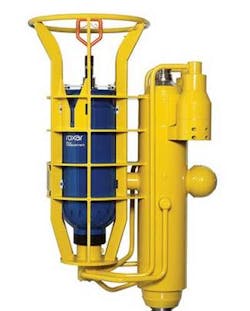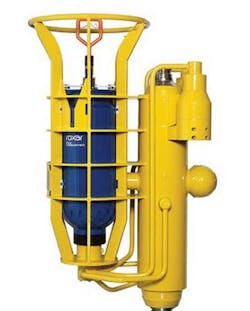DRILLING & PRODUCTION
Frank Hartley, Houston
Roxar’s subsea retrievable canister proven cost-effective
Roxar has patented a subsea multiphase meter’s subsea retrievable canister housing the meter’s electronics and flow computing modules.
The patent, which relates to a multiphase meter “directly attached to, but detachable from, a separately retrievable canister containing a multiphase flow meter detector,” follows qualification testing with ExxonMobil. The first two meters were installed in ExxonMobil’s Kizomba B field, offshore Angola, in 2004.
The benefits to the E&P operator of the subsea retrievable canister include cost-effective maintenance with limited subsea intervention requirements, high flow measurement availability, 100% redundancy on all electronics, easy installation, and simplified subsea structure design. The canister can be retrieved with through a standard ROV.
Over 80 subsea multiphase meters of this design have been ordered worldwide. Customers include ExxonMobil, Total, which is installing the meters in the Rosa oil field offshore Angola, and Cameron, which is installing the meters in the deepwater Akpo field offshore Nigeria.
Deepwater sand control contact awarded
Reliance Industries Ltd. (RIL) has awarded Halliburton’s Energy Services Group a $35-million contract for deepwater sand control completion technology in the Dhirubhai-I and Dhirubhai-3 fields offshore India.
The scope of the work includes products and installation services for upper completion for 18 wells and open hole gravel packs for 15 wells, with provision of appropriate back up equipment. Most of the wells will be completed with large inside diameter hardware to maximize the production capability of the wells. The gravel pack system, a field proven in deepwater, will accommodate monitoring technology across the reservoir for the first time in a deepwater sand control environment, according to Halliburton.
Q-Technology continues to evolve and expand
Schlumberger’s WesternGeco Q-Technol- ogy services have developed new technologies including WesternGeco DSC Dynamic Spread Control.
For offshore surveys, the DSC Dynamic Spread Control is the new automated vessel, source, and streamer steering technology. Field tests in the Gulf of Mexico resulted in repeatability for 4D time-lapse studies and increased accuracy in Q-enabled over/under and rich- and wide-azimuth surveys. The Q-Marine technology platform, consisting of steerable streamers, single-sensor acquisition, dense acoustic positioning network, and calibrated marine sources, continues to evolve with the addition of the DSC system.
Rubber thickness stator improves drilling
A new rubber thickness stator, the Moyno ERT Power Section from R&M Energy Systems, has improved the overall performance of power sections used in downhole drilling applications, according to R&M.
The company’s experience in stator engineering, manufacturing, and product application led to the development of stators with internal contours that are precision-machined rather than hydraulically formed. The resulting tubes feature durability and tolerancing that optimizes the benefits of even rubber thickness technology.
Applying an even thickness of rubber to the stator contour and supporting each lobe with steel minimizes the rubber’s degree of dimensional change during use due to temperature, chemical attack, and loading. This design allows it to produce up to 100% more power output compared to conventional stators resulting in higher ROPs.
The ERT’s high power density uses shorter power sections with performance outputs comparable to that of longer conventional product. This can improve the motor’s directional response as well as MWD and LWD measurement quality by placing their sensors closer to the bit.
Baker completes 100th Mono-Trip CemenThru system
Baker Oil Tools has completed its 100th Mono-Trip CemenThru system for Chevron in the Gulf of Thailand. The system is designed to add artificial lift capability and improved safety to cemented monobore wells with life expectancies of three to five years. Such short-lived wells have become common in the Gulf of Thailand and are gaining in other regions worldwide.
The system’s components, specifically designed for cement-through applications, include the CemenThru Side Pocket Mandrel (SPM) and the CementSafe Tubing Retrievable Surface Controlled Subsurface Safety Valve, as well as a hydraulically set liner top packer, a dual wiper plug, and a latch collar.
The completion system has proved to be an economical method of completing these wells which, in some cases, might not be feasible otherwise because of high completion costs, Baker says.
Previously, common completion practice for disposable wells was to complete the well in two stages. First, the tubing was cemented in place without use of a packer. Then, the operator had to recomplete the well by cutting above the cement and re-running completion strings with all the necessary equipment. This process was not only time consuming, but also dependent on the integrity of the cemented portion of the first stage.
By allowing operators to cement through the completion equipment, the system eliminates the cost and rig time associated with re-completing after cementing and thus reduces overall completion costs. In addition, the HSE concerns associated with additional completion runs are reduced. By allowing the system to be cemented offline and reducing non-productive time, rig costs are further reduced, according to Baker. Chevron was able to reduce rig time by 18 to 24 hours per completion.
Total contracts BJ for well services offshore Brunei
Total E&P Borneo B.V. has contracted BJ Tubular Services to provide a range of well services in Brunei Darussalam. This contract is for hammer conductor-driving, casing and tubing running, onshore shoe tracking, and miscellaneous make-up services for three wells on Total’s offshore development in block B, located approximately 50 km (31 mi) north of the capital city of Bandar Seri Begawan.
BJ will use two hydraulic hydrohammers to install three 30-in. (762-mm) conductors. The hydrohammers deliver precise, concentrated blows to the piling column, driving piles deeper and faster than other methods.
The work also includes running 13% chrome tubular completions and expandable liners from the new built jackup rigMaersk Completer. BJ will use its Chromemaster power tongs and modified running and handling tools to carry out this work.

